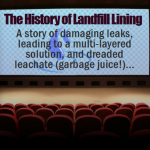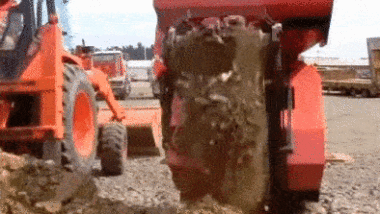Landfill linings are physical barrier systems intended to, as far as possible, prevent the escape of water and gases out of the body of the landfilled waste. A Landfill Liner is placed at the bottom and sides of modern landfills and are continuously welded to as far as possible provide a watertight seal.

They are necessary for securing the environment around every landfill. Making it safe from contamination from the waste.
High Quality Landfill Linings – An Essential Requirement
Utilising just the very best high quality landfill (or what many people call a “garbage dump”) lining products and ensuring that they are installed to a high level of continuity is vital.

A landfill lining should for all purposes effectively prevent the movement of leachate and also the escape of poisonous dissolved by-products. By-products which would otherwise which leach from the waste. If an aquifer, which is similar to an underground water reservoir in permeable rock, is close to a landfill, escaping leachate must be halted by the landfill liners installed.
Without the liners installed it would flow right into groundwater. Infiltration right into aquifers or neighbouring rivers must be prevented. If not, animals, plants, and even man can be harmed when drinking the water. If contamination of neighbourhood water resources occurs it is often a serious loss to the environment, and the local economy.
Landfill liner definition
A landfill liner, or composite liner, is a low permeable barrier, which is laid down below and around the sides of engineered landfill sites.
Until it deteriorates, the liner prevents the migration of leachate and landfill gas, at least to a degree.
Liners are used to line sanitary landfills (non-hazardous waste landfills – for acceptance of household, industrial and commercial waste) hazardous waste landfills, and increasingly often inert waste landfills.
Linings Must Effectively Reduce Leachate Flow

To be successful, the extent of leachate flow through landfill liners must be reduced to below the rate to which the natural flow of water in the surrounding soils can readily flush away the rate of escape of the contaminants. Landfill liners a re intended to prevent contamination of underlying aquifers and nearby rivers, preventing pollution of the local water.
Think of a landfill as a huge bathtub in the ground, where the liner is the bath. However, there is no plug hole and the landfill liners are not designed to be strong enough to hold back the leachate from a full “bath”/ landfill. In fact, they are usually only designed to hold the pressure from 1 or 2 metres of leachate (water) in the bottom.
What are landfill liners made of?
They are made from plastic polymers such as DPE, LLDPE, PVC, and Hypalon. Non-plastic linings are GCL, and synthetic bitumen based low-permeability macadams.
Looking at each material in turn:
DPE (Dense Polyethylene) can be used and most frequently landfill designers choose “High Density Polyethylene” (HDPE) for its combination of strength and flexibility to withstand loading while also possessing a comparatively good resistance to chemical attack.
- That a good liner for a landfill is made of HDPE is evident in the fact that HDPE is the default liner material approved within the EU Landfill Directive.
- LLDPE (Liner Low Density Polyethylene) is a multi-layer liner where the layering improves the flexibility and stretch-ability of the membrane. However, puncture resistance is inferior to HDPE.
- PVC is easy to weld, it can provide elongation and conformity. It is also highly impermeable, which is a very important factor when it comes to landfill containment. However, it requires the addition of a plasticiser and the difficult choice of suitable plasticizers has limited it's use.
- Hypalon is a trademark name for chlorosulfonated polyethylene (CSPE) synthetic rubber (CSM) noted for its resistance to chemicals, temperature extremes, and ultraviolet light. It has been a product of DuPont Performance Elastomers, a subsidiary of DuPont.
- GCL (Geosynthetic Clay Liner) is a product comprising a combination of naturally occurring “Bentonite Clay” resource, placed between layers of geotextile. The Bentonite clay in dry powdered form, is sandwiched between a woven and non woven geotextile. The result is a very strong lining product which holds its form under pressure. And yet, if damaged in punching and shear, or elongated, has been found to self-heal by absorbing water and expanding to fill any gaps.
- Synthetic bitumen based low-permeability macadams are constructed in the same manner as a highway pavement. However, whereas a road pavement is usually permeable, the material mix for a landfill liner application is designed to be very low permeability.
Hypalon has often been seen as premium priced, and possibly affordable, but can exhibit some impressive characteristics when used as a landfill lining material.
HDPE landfill liner – The Traditional Choice
HDPE is the commonly accepted standard lining material for landfill containment uses. For that matter it is also used when linings are needed for reservoirs, ponds, wastewater treatment plants, leachate lagoons etc.
Composite liner landfill requirements
“A landfill liner, or composite liner, is intended to be a low permeable barrier, which is laid down under engineered landfill sites. Until it deteriorates, the liner retards migration of leachate, and its toxic constituents, into underlying aquifers or nearby rivers, causing spoiling of the local water.
Modern landfills generally require a layer of compacted clay with a minimum required thickness and a maximum allowable hydraulic conductivity, overlaid by a high-density polyethylene geomembrane.”
via en.wikipedia.org
From the above you will understand that a composite landfill liner requires a belt-and-braces approach to lining design. A composite liner is a lining system which comprises two linings each one of which should be adequate, on its own, to prevent the escape of dangerous emissions from sanitary landfills.
Composite landfill lining design strategy
The strategy of composite landfill lining is a pragmatic one, based on experience.
Experience has shown that although in theory it is perfectly possible to line large areas perfectly, this rarely can be achieved. The reality is that it is extremely difficult for even experienced landfill lining installers to line landfills perfectly, in the real world. Liner damage is easily done, and it happens.
In general, a well quality controlled landfill liner will have 1 to 3 defects/ penetrations per hectare by the time the first lift of rubbish has been compacted above it.
“The main role a composite liner has for a municipal solid waste system for landfills is that is reduces the amount of leakage through small seep holes that sometimes form in the geomembrane part of the composite liner. The protection layer part serves as a preventer, stopping these holes forming inside the geomembrane. Holes which would allow the waste to leak through the entire liner. It also takes away the pressure and stress which can cause cracking and holes from forming in the membrane as well.”
via wikipedia.org
Composite linings are accepted practice
In much of the world the concept of composite linings is accepted practice. Elsewhere, the North American (US) philosophy is adopted. That is the use of double linings for sanitary landfills. In the event of leakage there is provision for removing the leachate from the space between the two lining membranes.
Compacted clay liner landfill requirements
Compacted clay liner landfill requirements reign supreme for most environmental regulators, over the use of GCLs wherever suitable clay is available. Whereas, GCLs are used in places where clay is not available or conserving landfill air space is particularly important.
The EU Landfill Directive prescribes that a 1 metre thickness of compacted clay of a permeability (K) no greater than 10 -9 m/sec is the minimum requirement.
Clays of this magnitude of permeability are reasonably common in Europe. Where not found, higher permeability clays can be produced by enhancement techniques where bentonite is mixed with the natural clay. This reduces the permeability of the resulting mixture.
Testing geological clay deposits
Clay liners for landfills are constructed from geological clay materials usually excavated on-site or quarried locally.
When designing a landfill the locally available clays are tested to assess permeability and hence the depth required.
Using the laboratory data, an engineer can calculate the thickness required to prevent the containment fluid from migrating a certain distance over a specified period of time. For example, if 500 years is the minimum time allowed for the fluid to escape from the site, a compacted liner with a mass hydraulic conductivity of 10 -8 cm/sec would have to be at least 5 feet thick. via www.911metallurgist.com
What is the best landfill liner thickness?
The best landfill liner thickness varies according to the membrane materials used, and the requirements of the local environmental regulatory bodies. For the most commonly used landfill lining material HDPE it's usually available in thicknesses ranging from 0.5mm to 2.5mm. In the UK 2mm is the thickness frequently used. For that reason we would suggest that 2mm HDPE is the “best” landfill liner thickness.
The best clay landfill liner thickness is usually judged to be the minimum permitted by the EU landfill Directive. This is 1 metre depth.
Which material is best as a liner for a landfill?
The material is best as a liner for a landfill, for sustainability and long-term robustness is thought to be low-permeability natural clay. This is where it is available locally, and subject to differing requirements according to local and site circumstances.
Landfill liner requirements
For all landfills designed in compliance with EU Standards the Landfill Directive applies to landfill liner requirements, in accordance with the following excerpt from the EU Landfill Directive 1999 (1999/31/EC):
- Landfill for hazardous waste: K ≤ 1,0 x 10-9 m/s; thickness a 5 m,
- Landfill for non-hazardous waste: K ≤ 1,0 x 10-9 m/s; thickness 1 m,
- Landfill for inert waste: K ≤ 1,0 x 10-7 m/s; thickness ?. 1 m,
via gov.uk-pb13563
Note: These are just part of the requirements. Refer to the directive for all the other requirements for landfill linings in accordance with EU requirements, and also apply local national standards which may introduce further requirements.
The best landfill liners types?
Although clay is generally thought to be the best landfill liners types, some chemicals can degrade clay. In addition, clays are fairly permeable to landfill gas.
The very best plastic landfill liners today are made of the tough plastic-film known as high density polyethylene (HDPE). Nevertheless, it must not be forgotten that a number of household chemicals will degrade HDPE. When this occurs the chemical permeating it or “passes through it”. On the way it can easily lose strength while softening it. In other circumstance the chemical may make it become brittle and crack.
These considerations bring us back to our earlier conclusion that each site is different. But in general, reworked compacted natural clay in combination within a composite lining design and an HDPE geomembrane is often best.
Understanding the Benefits and Drawbacks of Sanitary Landfill Sites
In this article, you will find out about the advantages and disadvantages of sanitary landfills. Deciding on the best way to handle rubbish, is a common challenge, especially in developing nations. Sanitary landfills offer one solution, but they come with pros and cons. This article will help you understand these landfill sites better, including their benefits and drawbacks. Stay […]
All UK Landfills to Close within 5 Years? Zero Waste UK
In this article we make the prediction that all UK Landfills will close within 5 Years. The current trend in waste reduction/ diversion from landfill shows that the nation will achieve Zero Waste to Landfill and quite soon as well. That momentous occasion will take place in 5 to 6 years time, according to the figures […]
The History of Landfill Lining Design [Infographic]
The Evolution of Landfill Lining Design in the UK from Dilute and Disperse to Full Containment The image above is one that we published back in 2004 and is one of the most important progressions in the history of landfills in the UK. It was a webpage in itself and rendered in efficient HTML code […]
Landfill Sites and the DSEA Regulations (DSEAR – UK)
Here is an explanation of the requirements of the DSEA Regulations and what they mean for landfill site owners and operators. All landfill owners (and by delegation their operators) fall under this regulation, and must act in order to comply with Dangerous Substances and Explosive Atmospheres Regulations (DSEAR) which have been in force since July 2006. DSEAR – […]








